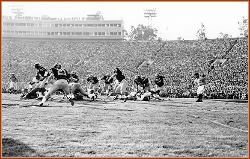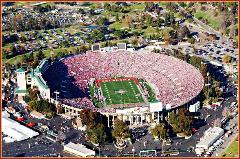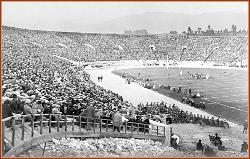



Beaver Stadium is located on the campus of The Pennsylvania State University and is
home to their college football team, the Nittany Lions. Named for James A. Beaver, a
former governor of Pennsylvania and president of the University's board of trustees,
the stadium currently has a capacity of 107,282, making it the second largest stadium
in the United States, smaller than Michigan Stadium by only 219 seats.
Five-hundred-seat Beaver Field, located behind the current site of the Osmond
Building, was the first permanent home for Penn State's football team, and the first
game played there was a Penn State victory over Western University of Pennsylvania
(now the University of Pittsburgh) on November 6, 1893. In 1909, New Beaver Field
opened just northeast of Rec Hall, roughly in the current location of the Nittany Parking
deck. It served as Penn State's stadium until the 1959 season, when the entire 30,000
seat stadium was dismantled and moved to the east end of campus, reassembled and
expanded, and dubbed Beaver
In 1960, Beaver Stadium had a capacity of 46,284, and expansions in 1969, 1974 and
1976 increased that to 60,203. In 1978, 16,000 seats were added when the stadium
was cut into sections and raised on hydraulic lifts, allowing the insertion of seating
along the inner ring of the stadium where the track had previously been located. In
1980, maximum capacity increased to 83,770. An expansion was completed for the
1991 football season, placing an upper deck addition over the north end zone and
raising capacity to over 90,000.
A major and somewhat controversial construction project took place in 2001, raising
the stadium's total capacity to 107,282. An upper deck was added to the south end of
the stadium, blocking the view of neighboring Mount Nittany (which had sentimental
value for some fans), but making Beaver Stadium the second largest stadium in the
United States.
In 2006, the stadium underwent major structural and aesthetic upgrades. Old steel
beams supporting the upper seats in the east, north and west were replaced and
strengthened, and new railing was installed, stronger than the old railing which
collapsed following the 2005 Ohio State game.
The appearance of the stadium has been enhanced with the addition of large blue
letters spelling out "The Pennsylvania State University" on the west-facing suites, and a
list of Penn State's undefeated, national championship, and Big Ten championship
years underneath. On the opposite side of the stadium, letters spelling, "Penn State
Nittany Lions" have been added to the press box, with "Beaver Stadium" running below.
Nine markers depicting the various traditions of Beaver Stadium, including the Blue
Band, the student section, and the blue buses which bring the team to the stadium,
have been placed around the stadium as well. In late October, the walls surrounding
the field were refaced with Pennsylvania limestone. An iron gate will soon replace the
current chain-link face at the players' entrance into the stadium.
Beaver Stadium's largest crowd of 110,753 was present for Penn State's 40-7 victory
over the University of Nebraska on September 14, 2002.[2] Penn State also set an
NCAA record in 2002 for largest season attendance, with 1,257,707 watching Penn
State games over the course of the season.
It is boasted by the Penn State community that during home games at State College
the stadium is the 3rd largest city by "population" in the state. It follows Philadelphia
(1,517,550) and Pittsburgh (334,563) and precedes Allentown (106,632).














